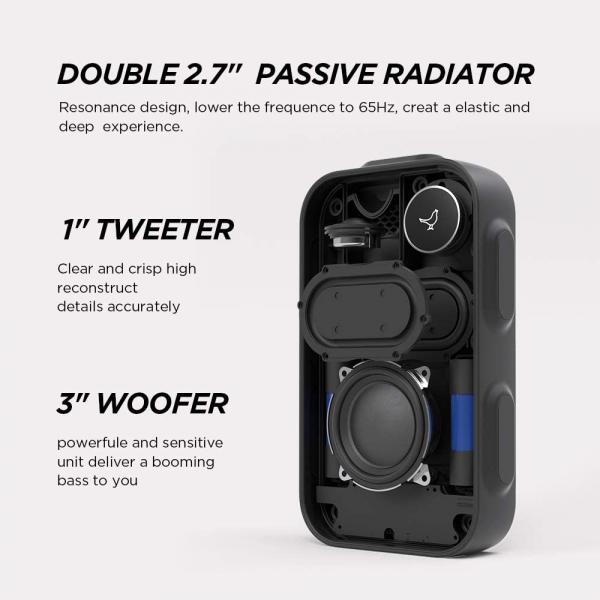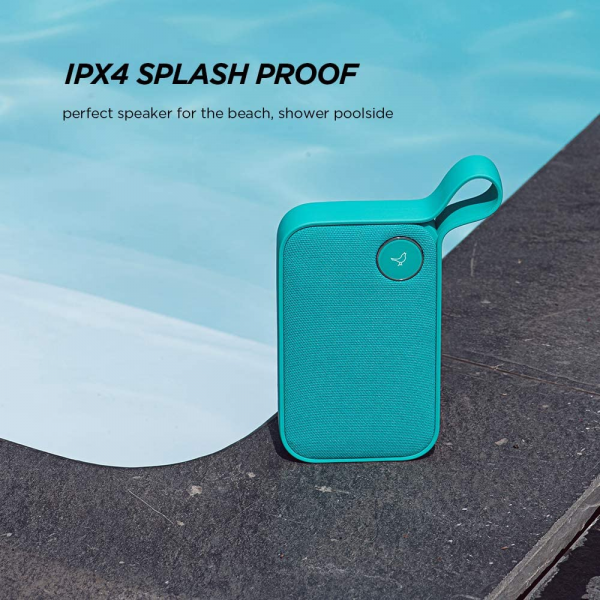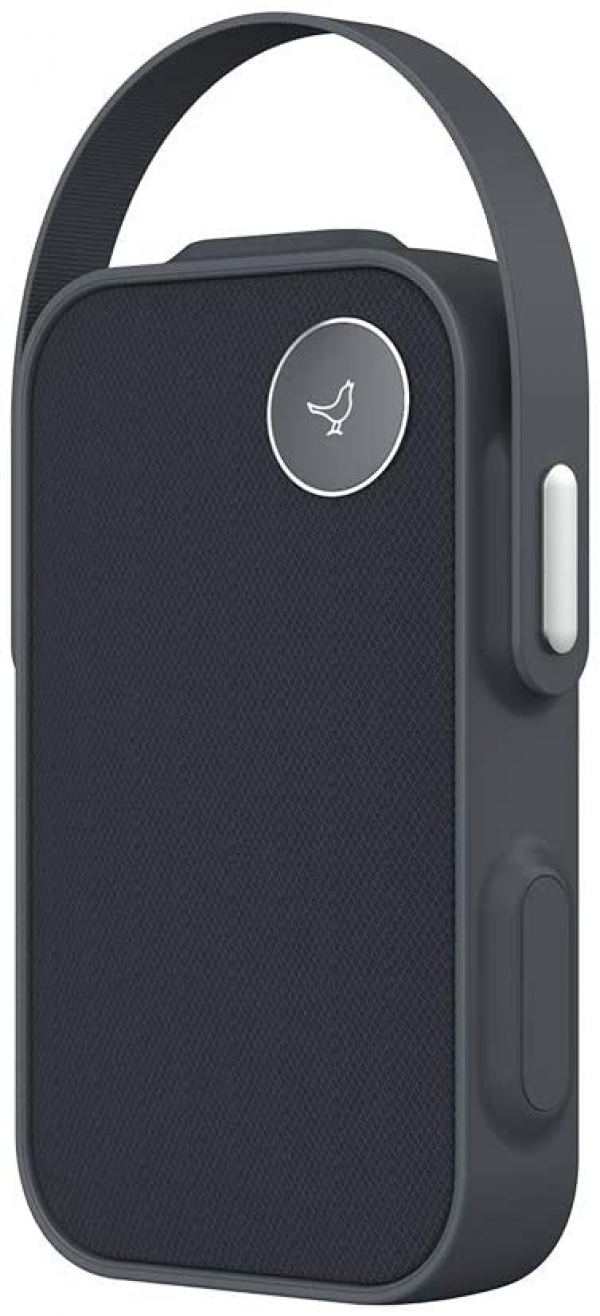Libratone
Libratone One Click: the elegant adventurer
Aprox. 159€ - see price -
See specificationsThe One Click is the oldest of the nomadic speakers of Libratone. To stand out, it relies on its modular and resistant design as well as on a quality 360 ° distribution. Will it seduce us as much as the excellent Zipp and Zipp Mini?
Positive points
Round and punchy bass.
Voices very present.
Good size / power / distortion ratio.
Robust construction.
Well thought out modular concept.
Fluid and complete use.
Good autonomy.
Bad points
Lack of homogeneity of distribution.
A little too shy treble.
No USB port for charging.
Bluetooth latency a bit limited.
Our review
Ergonomics
With its rounded shapes and sleek design, the One Click stays in the tone of the already known Libratone speakers. It consists of two parts: a solid base with two fabric grids and a large removable rubber part. The whole benefits from serious manufacturing with well-made finishes. In addition to its good general resistance to shocks and drops, the One Click offers increased resistance to splashing water (IPX4). The One Click can follow you without problem during your wanderings.
The speaker is not really compact and light, which is why we consider it as a transportable speaker. Its apparent simplicity hides a very interesting modular concept which facilitates transport and allows it to be hung everywhere. The rubber part conceals five locations (one above and two on each side) which allow it to accommodate a carabiner and / or a rubber strap. The latter can support the weight of the enclosure without any harm.
As usual, Libratone has integrated its faithful touch interface on its One Click. Even if it is not the most obvious to take in hand for neophytes (cf. our tests of the Zipp and Zipp Mini), it is very practical and reactive once mastered. It is also very complete: it is possible to control the listening volume, manage playback, calls, navigate between tracks, display the battery level and change the source.
To complete the experience, Libratone supports the One Click with a dedicated mobile application (iOS and Android). In addition to acting as a real remote control, it gives the possibility of linking two One Click wireless speakers and choosing from several equalization profiles.
The One Click can be connected via Bluetooth (4.0) or connected via the 3.5 mm mini-jack input hidden behind the rubber cover. The wireless connection is made very quickly and easily, in particular thanks to the luminous and audible indications which make it possible to follow its good progress. We also find the hands-free kit function via the integrated microphone, which does an honorable job. Our voice is relatively clear and distinct, while remaining fairly well detached from the surrounding noises. However, you have to stay within 2 meters to be a minimum understood.
Another good surprise in terms of autonomy, the enclosure surpasses the promises made by the manufacturer. Indeed, we were able to push its duration of use to almost 20 h, which is much more than the 12 h promised, and this with a very comfortable listening level. In the end, our only real regret is not finding a USB port for recharging, which is quite surprising given the size of the One Click.

Audio
All the sound performance of the One Click is based on a three inch woofer, a one inch tweeter and a bass radiator: a rather curious choice for a speaker that relies on a 360 ° broadcast. This is unfortunately felt when listening, especially because of the directivity of the tweeter and the woofer. We are much more faced with a mono rendering at 180 °, with a little more balance towards the rear face of the speaker.
The One Click offers a powerful, precise and warm sound rendering. Failing to flirt with the bass extremes for more depth, the speaker puts on a more present and rounder bass. This warm feeling is also due to the timidity of the treble, but it is not invasive. Fans of suave and soft voices will be served, as are those looking for a flattering look for cellos, basses, large percussions or even electric guitars on their neck pickups.
The mediums are not to be outdone, because they bring a beautiful presence and a good edge to all the sources which operate in this register, in particular as regards the voices. At very high volume and near the speaker, some notes may seem a little too incisive, for example around 2.9 kHz (note Fa7 / Fa # 7), but this remains very occasional. We can correctly distinguish the different layers of the scene. The different EQs offered by the application are subtle enough to be interesting in certain situations.
The One Click shows good power given its size. It can easily sound a room large enough for an aperitif with friends or an outdoor outing. Even at a very high level, it is difficult to fault it. Distortion remains particularly low across the spectrum, whether wired or wireless.
The communication latency in Bluetooth remains a little too high not to distinguish a difference between the image and the sound. However, this is still acceptable at this level, especially when it comes to viewing a video on the move.

Conclusion
Although the magic does not work as well as with the Zipp, the One Click remains a very interesting transportable speaker. It will appeal to those looking for an elegant and powerful speaker, which can be carried and hung everywhere. It lacks only a USB port, a true homogeneous 360 ° rendering and a little more contained Bluetooth latency to classify it among the very best.

Specifications
Reviews


I agree with everybody else
I'm going to pretty much echo what other reviewers have said about the Libratone ONE Click. I had been shopping bluetooth speakers in local retailers, and It seemed to my ears as a semi-pro musician who's spent a ton of hours in recording studios that most of the speakers on the market are engineered to deliver X-TREME SLAMMIN BASS BEATS! !!! Some of these tiny terrors are really amazing in this regard (eg, the JBL Extreme), and can literally shake the windows at max volume. This is great for some kinds of music. But when I'd pair my phone with these units and play MY music (lots of acoustic, Americana, trippy world music and such), the bass was simply muddy and overwhelming.
The ONE Click delivers a really balanced frequency response throughout the sonic spectrum, and does not over-emphasize any frequency range. So you can play folk music, symphonic and chamber music, mainstream jazz, and just about anything through this unit with amazing results. My favorite aspect of this speaker is that it doesn't "beam" to a sweet spot directly in front of the unit (I'm talkin to you, Bose). I've tried placing this in a number of spots in my listening space, and as long as it's within about 12 "of a wall, it really doesn't matter where you are in the room, it sounds the same. What's truly amazing to me is that you can be totally off-axis, and still perceive the stereo soundstage. Amazing technology.
So, FOR ME, this is a five-star purchase. If you want something truly loud (like bumpin down the road setting off because alarms loud), you'll need t look elsewhere. If you're jammin 50 Cent or Rihanna, this is probably not going to give you what you're looking for ... as another reviewer pointed out, the claim that this speaker delivers more bass than the competition is simply not true. The bass is balanced ... and when it's an acoustic upright bass in the recording, that's what it sounds like (rather than like a digital bass synth). This speaker is all about clarity. My first try-out was with one of my favorite albums ("Chinatown") by one of my favorite bands (The Be Good Tanyas), and the acoustic guitar and mandolin sounded like they were being played in my bedroom ... the upright bass had that rich, "stringy" quality. I think a pair of these could be used for studio monitors if they were capable of cranking out more decibels ... they are that precise.
Haven't played with the hooks and handles yet, but I reckon they will come in handy. I've looked at the app. Not much there to talk or worry about, which is just fine with me (if I'm using an app to play my music, do I really want to have to run another app to control my speaker? Hint: no).
I am 100% satisfied with this purchase. Already thinking that I might need another one ....
A must have for people who love music
There's a big difference between speakers in the budget price range, less than $ 50 and those in the $ 100-200 range. The Libratone ONE Click is a fantastic Bluetooth speaker for those of you who want high quality sound. It has some weight to it - that usually means good internals like a powerful amp, big battery and bigger drivers which equate to better sound. The One Click has a very rich and balanced sound signature that is suitable for most ears. It has a very nice build quality with soft speaker covers that don't distort sound and a rubber outer band that can be removed and adjusted with clips or handles (whatever your preference).
I like that I can pair two as any speakers sound better in stereo mode. If you want more from your audio without spending an arm and a leg, and want more than budget, the ONE Click finds the sweet spot of performance and price. I highly recommend this speaker if you want to really enjoy your music.
Super cool speaker for a perfect price
Finally - after years of buying various listening devices, this Libratone One Click is the best Bluetooth speaker I've owned. The design of the speaker is like a self-contained carry case. You can connect accessories (which are included) to create handles and hanging hooks to listen anywhere. Fits right in on a bookshelf, kitchen counter, towel hook in the bathroom.
The touch volume controls are in a cool design. The makers of this product really kept the simplicity in mind. Port cover in the back keeps everything hidden. I have the graphite gray model, but the red and caribbean green ones look pretty nice too.
The sound is really full with a good amount of bass. With previous speakers, I've never been satisfied with the range of sound. But now with this Libratone, I'm getting good sound in any room where I put the speaker down. I've always thought it would be cool to have a fancy outdoor sound system for my backyard patio area, and now I feel like I instantly have one. I can place the speaker wherever I want it out back, even hang it up out of sight, and now I have big sound outdoors for parties or gatherings.
Love this speaker! So glad I got it.